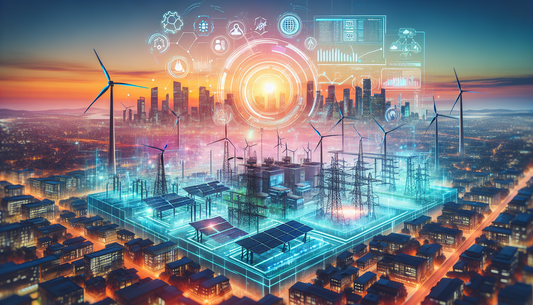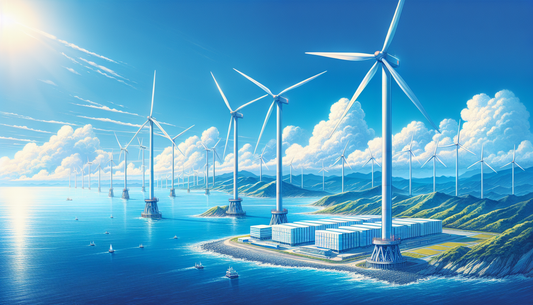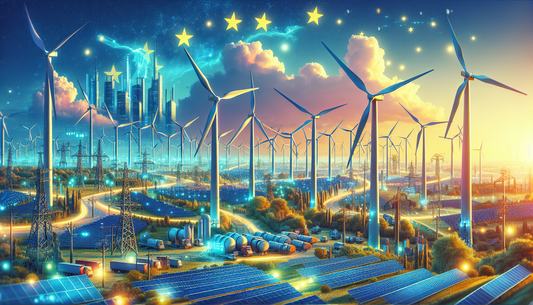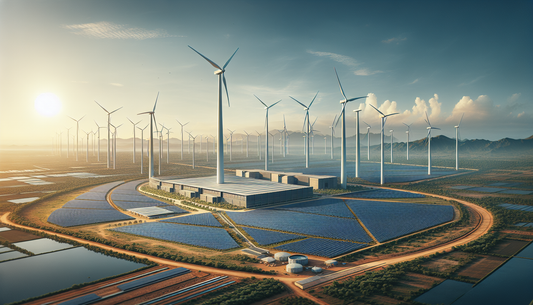Anti-Aging News

Revolutionizing German Steel: Renewable Energy and Hydrogen Integra...
Germany is taking significant strides in transforming its steel industry by incorporating renewable energy sources and hydrogen technology, aiming to reduce carbon emissions and set a global precedent for sustainable industrial practices. This transformation is a key component of Germany's ambitious climate targets.
- 🌍 Location: Ruhr Valley, Germany - the heartland of Germany's steel production.
- ⚡ Renewable Energy: With the focus on wind and solar energy, steel plants are transitioning from traditional fossil fuels to renewable electricity, helping to curb their carbon footprint.
- 🔋 Hydrogen Integration: Hydrogen is being increasingly utilized as a cleaner energy source for steel production, replacing coal in the smelting process.
- Prominent Players: Salzgitter AG and Thyssenkrupp, two of Germany's largest steel producers, are spearheading projects to incorporate hydrogen in steel manufacturing.
- Key Milestone: By 2030, Germany aims to significantly cut down its steel industry's carbon emissions, aligning with EU's Green Deal targets.
This sustainable shift not only reinforces Germany's leadership in climate innovation but also demonstrates the role of industrial sectors in combating climate change. Through enhanced international collaborations, the German steel industry is set to become a benchmark for global change. 🌱🔧
- Click to read the full article
Revolutionizing German Steel: Renewable Energy and Hydrogen Integra...
Germany is taking significant strides in transforming its steel industry by incorporating renewable energy sources and hydrogen technology, aiming to reduce carbon emissions and set a global precedent for sustainable industrial practices. This transformation is a key component of Germany's ambitious climate targets.
- 🌍 Location: Ruhr Valley, Germany - the heartland of Germany's steel production.
- ⚡ Renewable Energy: With the focus on wind and solar energy, steel plants are transitioning from traditional fossil fuels to renewable electricity, helping to curb their carbon footprint.
- 🔋 Hydrogen Integration: Hydrogen is being increasingly utilized as a cleaner energy source for steel production, replacing coal in the smelting process.
- Prominent Players: Salzgitter AG and Thyssenkrupp, two of Germany's largest steel producers, are spearheading projects to incorporate hydrogen in steel manufacturing.
- Key Milestone: By 2030, Germany aims to significantly cut down its steel industry's carbon emissions, aligning with EU's Green Deal targets.
This sustainable shift not only reinforces Germany's leadership in climate innovation but also demonstrates the role of industrial sectors in combating climate change. Through enhanced international collaborations, the German steel industry is set to become a benchmark for global change. 🌱🔧
- Click to read the full article

Delays Challenge Central Vietnam's Hai Lang LNG Power Project
The Hai Lang LNG Power Project in central Vietnam is facing delays, raising concerns over energy supply stability in the region. This ambitious project, which aims to produce cleaner energy, is located in Quang Tri Province and has encountered several roadblocks.
- The project, set to enhance Vietnam's energy infrastructure, involves significant investment and collaboration with foreign companies.
- One key player is the American engineering firm Bechtel, which is involved in the construction phase.
- Completion was initially slated for early 2024, but current delays hint at a possible pushback to 2025 or later.
- Adverse weather conditions and unforeseen logistical issues have been primary factors causing these delays.
- The project is crucial for transitioning to sustainable energy, intending to reduce coal dependency.
- The delay poses ramifications not just for local energy supply but also for regional economic growth.
- Officials are working to mitigate issues; however, stakeholders are anxious about further postponements.
These challenges highlight the complexities of large-scale energy projects and the need for adaptive planning to ensure timely completion.
- Click to read the full article
Delays Challenge Central Vietnam's Hai Lang LNG Power Project
The Hai Lang LNG Power Project in central Vietnam is facing delays, raising concerns over energy supply stability in the region. This ambitious project, which aims to produce cleaner energy, is located in Quang Tri Province and has encountered several roadblocks.
- The project, set to enhance Vietnam's energy infrastructure, involves significant investment and collaboration with foreign companies.
- One key player is the American engineering firm Bechtel, which is involved in the construction phase.
- Completion was initially slated for early 2024, but current delays hint at a possible pushback to 2025 or later.
- Adverse weather conditions and unforeseen logistical issues have been primary factors causing these delays.
- The project is crucial for transitioning to sustainable energy, intending to reduce coal dependency.
- The delay poses ramifications not just for local energy supply but also for regional economic growth.
- Officials are working to mitigate issues; however, stakeholders are anxious about further postponements.
These challenges highlight the complexities of large-scale energy projects and the need for adaptive planning to ensure timely completion.
- Click to read the full article

Unlocking the Potential of Virtual Power Plants for a Sustainable Grid
Amid growing concerns over climate change, virtual power plants (VPPs) are being heralded as a transformative force for sustainable energy management worldwide. Companies like Tesla and Siemens are spearheading this change, deploying VPPs to optimize grid stability and energy efficiency.
- 🌍 Global Impact: In Germany, Australia, and the United States, VPPs are leading the shift towards smarter energy systems, allowing for better energy distribution and conservation.
- 🔄 How VPPs Work: These digital networks combine multiple energy sources such as solar, wind, and battery storage to function as a single power plant, providing a reliable and flexible energy supply.
- 💡 Technological Advances: Innovations in smart meters and data analytics are crucial to the effectiveness of VPPs, ensuring real-time monitoring and responsiveness to energy demands.
- 📈 Economic and Environmental Benefits: VPPs promote renewable energy usage, reduce carbon emissions, and can potentially lower electricity costs for consumers.
- 🔗 Future Prospects: With increasing investment and supportive policies, VPPs are poised to become integral to sustainable grid infrastructure, fostering energy independence and environmental resilience.
- Click to read the full article
Unlocking the Potential of Virtual Power Plants for a Sustainable Grid
Amid growing concerns over climate change, virtual power plants (VPPs) are being heralded as a transformative force for sustainable energy management worldwide. Companies like Tesla and Siemens are spearheading this change, deploying VPPs to optimize grid stability and energy efficiency.
- 🌍 Global Impact: In Germany, Australia, and the United States, VPPs are leading the shift towards smarter energy systems, allowing for better energy distribution and conservation.
- 🔄 How VPPs Work: These digital networks combine multiple energy sources such as solar, wind, and battery storage to function as a single power plant, providing a reliable and flexible energy supply.
- 💡 Technological Advances: Innovations in smart meters and data analytics are crucial to the effectiveness of VPPs, ensuring real-time monitoring and responsiveness to energy demands.
- 📈 Economic and Environmental Benefits: VPPs promote renewable energy usage, reduce carbon emissions, and can potentially lower electricity costs for consumers.
- 🔗 Future Prospects: With increasing investment and supportive policies, VPPs are poised to become integral to sustainable grid infrastructure, fostering energy independence and environmental resilience.
- Click to read the full article

Google Powers Taiwan Data Center with Offshore Wind Energy Initiative
Google has taken a significant step in its commitment to sustainability by powering its Taiwan data center with an offshore wind energy initiative. This forward-thinking strategy underscores the tech giant's dedication to renewable energy and reducing carbon emissions.
- Location: The initiative is centered in Taiwan, where Google operates one of its data centers.
- Renewable Energy: The move involves utilizing offshore wind energy, marking a major shift towards clean energy sources for powering data operations.
- Google's Commitment: This project aligns with Google's ambitious goal to operate on carbon-free energy 24/7 at all of its data centers by 2030.
- Offshore Wind Farm: The wind energy is sourced from a local offshore wind farm, demonstrating Google's investment in Taiwanese clean energy projects.
- Timeline: The transition to using offshore wind energy represents a timely advancement in Google's ongoing sustainability efforts, although the exact initiation date was not specified.
- Impact: This initiative is part of a broader trend of tech companies seeking greener alternatives, aiming to lessen their environmental footprint and promote environmental sustainability.
Google's embrace of offshore wind energy in Taiwan sets a precedent for other global corporations to follow in the pursuit of sustainable operations.
- Click to read the full article
Google Powers Taiwan Data Center with Offshore Wind Energy Initiative
Google has taken a significant step in its commitment to sustainability by powering its Taiwan data center with an offshore wind energy initiative. This forward-thinking strategy underscores the tech giant's dedication to renewable energy and reducing carbon emissions.
- Location: The initiative is centered in Taiwan, where Google operates one of its data centers.
- Renewable Energy: The move involves utilizing offshore wind energy, marking a major shift towards clean energy sources for powering data operations.
- Google's Commitment: This project aligns with Google's ambitious goal to operate on carbon-free energy 24/7 at all of its data centers by 2030.
- Offshore Wind Farm: The wind energy is sourced from a local offshore wind farm, demonstrating Google's investment in Taiwanese clean energy projects.
- Timeline: The transition to using offshore wind energy represents a timely advancement in Google's ongoing sustainability efforts, although the exact initiation date was not specified.
- Impact: This initiative is part of a broader trend of tech companies seeking greener alternatives, aiming to lessen their environmental footprint and promote environmental sustainability.
Google's embrace of offshore wind energy in Taiwan sets a precedent for other global corporations to follow in the pursuit of sustainable operations.
- Click to read the full article

Harnessing Wind Power for Ukraine's EU Energy Integration
Harnessing the power of wind energy is crucial for Ukraine as it seeks to deepen its integration with the European Union's energy infrastructure. The country is strategically placing emphasis on developing its vast wind energy potential to not only meet its own energy needs but also contribute to the EU's renewable energy goals. 🌍
- Location: Ukraine, particularly the southern and eastern regions, have significant wind energy potential due to their geographical and climatic conditions.
- Notable Persons: Ukrainian Energy Minister German Galushchenko has been actively advocating for increased investment in renewable energy, emphasizing wind power's role in transitioning from reliance on fossil fuels.
-
Timeline:
- Early 2022: Discussions intensified on renewable energy projects to align with European standards.
- Mid-2023: Specific projects in the Zaporizhzhia region were initiated, focusing on wind farm development. 🌬️
- Late 2023: Investments have increased as Ukraine reported significant milestones in wind power capacity, largely driven by collaboration with European companies.
- Strategic Importance: Wind energy development not only aids Ukraine in achieving energy independence but also acts as a bridge in bolstering energy ties with Europe.
- Economic Impact: Expansion in the wind sector is projected to create jobs, boost regional economies, and enhance Ukraine's geopolitical stance in Europe.
- Click to read the full article
Harnessing Wind Power for Ukraine's EU Energy Integration
Harnessing the power of wind energy is crucial for Ukraine as it seeks to deepen its integration with the European Union's energy infrastructure. The country is strategically placing emphasis on developing its vast wind energy potential to not only meet its own energy needs but also contribute to the EU's renewable energy goals. 🌍
- Location: Ukraine, particularly the southern and eastern regions, have significant wind energy potential due to their geographical and climatic conditions.
- Notable Persons: Ukrainian Energy Minister German Galushchenko has been actively advocating for increased investment in renewable energy, emphasizing wind power's role in transitioning from reliance on fossil fuels.
-
Timeline:
- Early 2022: Discussions intensified on renewable energy projects to align with European standards.
- Mid-2023: Specific projects in the Zaporizhzhia region were initiated, focusing on wind farm development. 🌬️
- Late 2023: Investments have increased as Ukraine reported significant milestones in wind power capacity, largely driven by collaboration with European companies.
- Strategic Importance: Wind energy development not only aids Ukraine in achieving energy independence but also acts as a bridge in bolstering energy ties with Europe.
- Economic Impact: Expansion in the wind sector is projected to create jobs, boost regional economies, and enhance Ukraine's geopolitical stance in Europe.
- Click to read the full article

India Advances with Gigawatt-Scale Renewable Energy Project
India is making significant strides in renewable energy with its latest gigawatt-scale project, guided by Prime Minister Narendra Modi's vision for a sustainable future. This ambitious initiative is set to enhance India's energy independence and reduce its carbon footprint, placing the nation at the forefront of global renewable energy advancements. The project underscores India's commitment to the Paris Agreement and is a pivotal step towards its goal of achieving 450 gigawatts of renewable energy by 2030.
- 🌏 Location: The project is primarily located in the western state of Gujarat, renowned for its solar and wind potential.
- 🔆 Scope: The venture includes solar, wind, and hybrid energy systems, bolstering India's renewable capacity.
- 📅 Timeline: Construction began in early 2023, with the first phase expected to be operational by 2025.
- 👥 Key Figures: Minister of New and Renewable Energy, R.K. Singh, highlights the project as a revolutionary move in India's energy sector.
- 💰 Investment: The project has attracted significant domestic and international investments, reflecting global confidence in India's renewable energy potential.
- 🚀 Impact: This initiative will create numerous jobs, boost local economies, and contribute to a cleaner environment.
- Click to read the full article
India Advances with Gigawatt-Scale Renewable Energy Project
India is making significant strides in renewable energy with its latest gigawatt-scale project, guided by Prime Minister Narendra Modi's vision for a sustainable future. This ambitious initiative is set to enhance India's energy independence and reduce its carbon footprint, placing the nation at the forefront of global renewable energy advancements. The project underscores India's commitment to the Paris Agreement and is a pivotal step towards its goal of achieving 450 gigawatts of renewable energy by 2030.
- 🌏 Location: The project is primarily located in the western state of Gujarat, renowned for its solar and wind potential.
- 🔆 Scope: The venture includes solar, wind, and hybrid energy systems, bolstering India's renewable capacity.
- 📅 Timeline: Construction began in early 2023, with the first phase expected to be operational by 2025.
- 👥 Key Figures: Minister of New and Renewable Energy, R.K. Singh, highlights the project as a revolutionary move in India's energy sector.
- 💰 Investment: The project has attracted significant domestic and international investments, reflecting global confidence in India's renewable energy potential.
- 🚀 Impact: This initiative will create numerous jobs, boost local economies, and contribute to a cleaner environment.
- Click to read the full article
